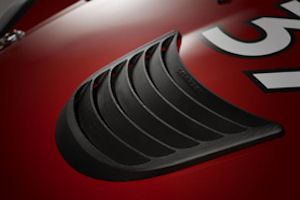Motor Trends: Additive Manufacturing Drives Production of Race-Ready Parts
September 4, 2014
Dear Desktop Engineering Reader:
On an assignment a few years back, I found myself wandering around the pits at a qualifying event for the FIA (Fédération Internationale de l’Automobile) World Endurance Championship. These souped-up luxury cars sported all sorts of hard-plastic pieces such as air duct connectors or air intake vents that I was pretty sure were made with an additive manufacturing process. No one would confirm or deny that when asked. Now, however, the cat is out of the bag. Well, sort of.
“Motor Trends: Additive Manufacturing Drives Production Of Race-Ready Parts” takes a quick look at how car race teams use FDM (fused deposition modeling) additive manufacturing systems from Stratasys for DDM (direct digital manufacturing) of production parts. “Production parts” as in parts designed to withstand the brutal conditions of motor race competition. It’s certainly a fun read.
 For years now, it’s been common knowledge that motor sports designers and engineers leverage additive manufacturing for prototyping designs, testing and evaluation. They still do that. But what this paper gives you is a peek into how and why three teams – Stewart-Haas Racing, Joe Gibbs Racing and Prodrive – use FDM-built parts in the cars they race in NASCAR or a FIA World Rally Championship (WRC) competition. And we’re not just talking about plastic side mirror covers. Some of these parts are taking a beating.
For years now, it’s been common knowledge that motor sports designers and engineers leverage additive manufacturing for prototyping designs, testing and evaluation. They still do that. But what this paper gives you is a peek into how and why three teams – Stewart-Haas Racing, Joe Gibbs Racing and Prodrive – use FDM-built parts in the cars they race in NASCAR or a FIA World Rally Championship (WRC) competition. And we’re not just talking about plastic side mirror covers. Some of these parts are taking a beating.
Why these teams use FDM to make production parts is rather simple. Basically, FDM technology enables design innovation. You simply can do things on an FDM system that you cannot do with any other manufacturing process or cannot afford to do on a CNC (computer numeric control) machine. Additionally, FDM can eliminate the need for settling on a nearly-as-good part, shave time off redesign cycles, shed part weight and save on tooling.
Take Stewart-Haas Racing as an example. One of its design engineers describes how FDM let the team easily create an oversized radio knob with a D-shaped mounting hole that would have taken forever to fabricate on a CNC. The same engineer tells about a custom air duct connector he made. His options were machining, molding, composite lay-up, using a near-miss off-the-shelf part or building an FDM part that matched his requirements exactly. A few hours after making the design, he had the FDM part.
Over at Joe Gibbs Racing, designers used their FDM system to build carbon monoxide filter housings out of a polycarbonate material. Two reasons for that choice. One, the polycarbonate material they’re using can handle temperatures of up to 200 °F (93 °C) over a four-hour race. Two, the polycarbonate materials reduce the housing’s weight to the bare minimum, which is something of a holy grail with race car design.
The UK’s Prodrive race team has an interesting story. They’re gearing up for a FIA WRC competition. WRC sends competitors racing around extreme mostly dirt courses for a few days. These are the races where you see cars hit jumps, fly more than 150 feet and bash down on the ground. So, they’re designed to bust up the driver and car.
Anyway, Prodrive uses its FDM machine to make parts such as gauge pods and hood vents for its MINI John Cooper. So, they design new wheel arches and build them in 24 hours. Only the FIA officials did not like their aerodynamics. Prodrive then redesigned and remanufactured the wheel arches and obtained FIA’s sign-off within the next 24 hours. The wheel arches, by the way, took the WRC beating in stride.
The cloak-and-dagger aspect of intense behind-the-scenes motor racing design and engineering remains fully in force in spite of FDM and other possible additive manufacturing techniques being implemented. Prodrive, for example, acknowledges that its MINI John Cooper uses at least 15 FDM parts. But it could well use more FDM parts. If it should, these would be the parts that you keep quiet about.
You don’t have to be stealthy about reading “Motor Trends: Additive Manufacturing Drives Production of Race-Ready Parts,” Download your complimentary copy from today’s Check it Out link then send it around to your coworkers. It’s a good read that informs and amuses.
Thanks, Pal. – Lockwood
Anthony J. Lockwood
Editor at Large, Desktop Engineering
Download “Motor Trends: Additive Manufacturing Drives Production of Race-Ready Parts” here.
Subscribe to our FREE magazine, FREE email newsletters or both!
About the Author
Anthony J. Lockwood is Digital Engineering’s founding editor. He is now retired. Contact him via [email protected].
Follow DE






